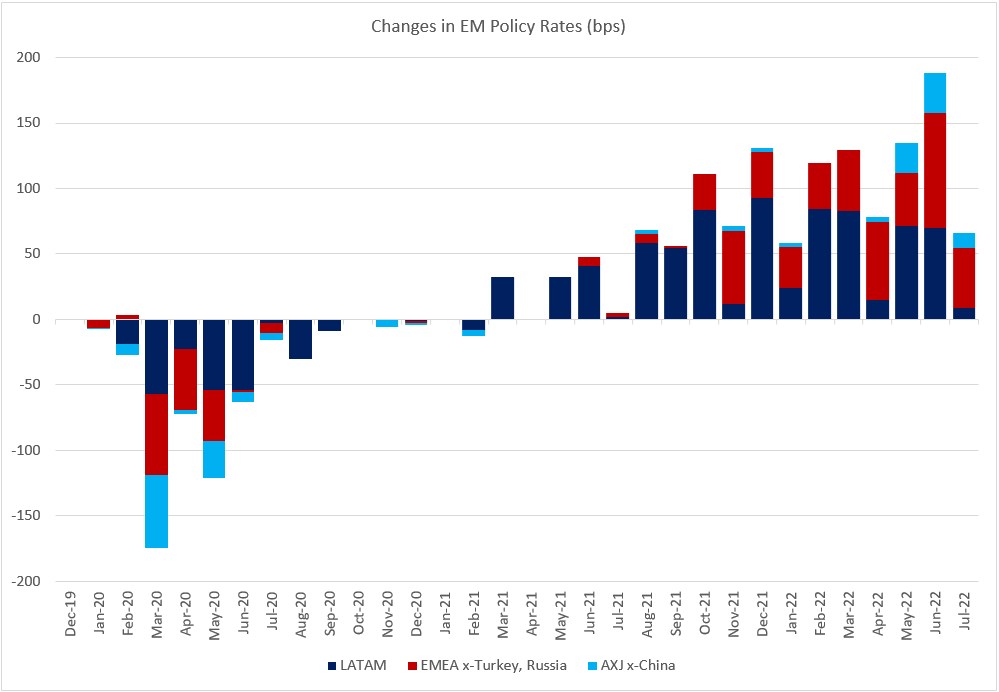By Natalia Gurushina
Chief Economist, Emerging Markets Fixed Income
Aggressive Frontloading of Hikes in EM Asia
Sometimes it is good to be a latecomer – one can learn from others’ mistakes. It looks like central banks in EM Asia noticed that a proactive response (frontloading of rate hikes) to rising inflation pressures (like in Brazil) is much better than policy procrastination (like in Poland). This definitely explains a wave of inter-meeting tightening in the region. India started the trend with a 40bps “emergency” rate hike back in May. The Philippines surprised yesterday with a sizable 75bps inter-meeting move. And Singapore’s monetary authority followed up with the second off-cycle upward re-centering of its policy band. Asia’s role in emerging markets (EM) overall tightening is getting more prominent these days (see chart below), as some trailblazers like Brazil are gradually winding down their cycles.
Market Expectation of Larger Fed Hikes
Some commentators are wondering whether a greater sense of urgency in EM Asia is related to the market expectation of larger rate hikes in the U.S., following a big upside inflation surprise in June. The Fed Funds Futures now almost fully “digested” a 100bps hike in July, followed by 75bps more in September. One thing that is unchanged is that the U.S. Federal Reserve (Fed) is expected to finish its tightening cycle in December and start cutting rates in 2023 – presumably due to a growing risk of recession. Timely frontloading/liftoff in EM Asia leaves room for a slower pace of rate hikes later on, but it is hard to see tightening cycles in the region be over in 5-6 months (in sync with the Fed).
Some EM Hikes Underwhelm
Today’s “shock and awe” policy move in the Philippines underscores once again that not all rate hikes of the same magnitude are created equal. The central bank of Chile also raised its policy rate by 75bps yesterday, but the market reaction was more like “it could have been worse at +50bps”. It was definitely not enough to stabilize the currency, which opened about 250bps weaker against the U.S. dollar this morning. And the central bank better deliver on its guidance to continue tightening in the coming months. The next important policy milestones in EM are rate-setting meetings in the Czech Republic and Thailand. The Czech National Bank’s departing hawks delivered a super-sized “goodbye” hike in June, and the local swap curve prices in no additional tightening in the next 3 months. Thailand’s central bank meets in August about 1 week after the inflation release – what are the chances of a “mega” 75bps liftoff if headline inflation moves above 8% year-on-year? Stay tuned!
Chart at a Glance: EM Asia – Frontloading Hikes To Avoid Policy Mistakes

Source: VanEck Research; Bloomberg LP
For more news, information, and strategy, visit the Beyond Basic Beta Channel.
PMI – Purchasing Managers’ Index: economic indicators derived from monthly surveys of private sector companies. A reading above 50 indicates expansion, and a reading below 50 indicates contraction; ISM – Institute for Supply Management PMI: ISM releases an index based on more than 400 purchasing and supply managers surveys; both in the manufacturing and non-manufacturing industries; CPI – Consumer Price Index: an index of the variation in prices paid by typical consumers for retail goods and other items; PPI – Producer Price Index: a family of indexes that measures the average change in selling prices received by domestic producers of goods and services over time; PCE inflation – Personal Consumption Expenditures Price Index: one measure of U.S. inflation, tracking the change in prices of goods and services purchased by consumers throughout the economy; MSCI – Morgan Stanley Capital International: an American provider of equity, fixed income, hedge fund stock market indexes, and equity portfolio analysis tools; VIX – CBOE Volatility Index: an index created by the Chicago Board Options Exchange (CBOE), which shows the market’s expectation of 30-day volatility. It is constructed using the implied volatilities on S&P 500 index options.; GBI-EM – JP Morgan’s Government Bond Index – Emerging Markets: comprehensive emerging market debt benchmarks that track local currency bonds issued by Emerging market governments; EMBI – JP Morgan’s Emerging Market Bond Index: JP Morgan’s index of dollar-denominated sovereign bonds issued by a selection of emerging market countries; EMBIG – JP Morgan’s Emerging Market Bond Index Global: tracks total returns for traded external debt instruments in emerging markets.
The information presented does not involve the rendering of personalized investment, financial, legal, or tax advice. This is not an offer to buy or sell, or a solicitation of any offer to buy or sell any of the securities mentioned herein. Certain statements contained herein may constitute projections, forecasts and other forward looking statements, which do not reflect actual results. Certain information may be provided by third-party sources and, although believed to be reliable, it has not been independently verified and its accuracy or completeness cannot be guaranteed. Any opinions, projections, forecasts, and forward-looking statements presented herein are valid as the date of this communication and are subject to change. The information herein represents the opinion of the author(s), but not necessarily those of VanEck.
Investing in international markets carries risks such as currency fluctuation, regulatory risks, economic and political instability. Emerging markets involve heightened risks related to the same factors as well as increased volatility, lower trading volume, and less liquidity. Emerging markets can have greater custodial and operational risks, and less developed legal and accounting systems than developed markets.
All investing is subject to risk, including the possible loss of the money you invest. As with any investment strategy, there is no guarantee that investment objectives will be met and investors may lose money. Diversification does not ensure a profit or protect against a loss in a declining market. Past performance is no guarantee of future performance.







